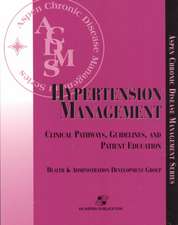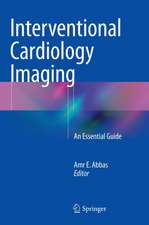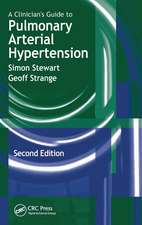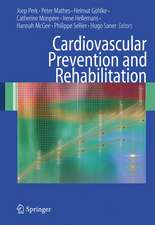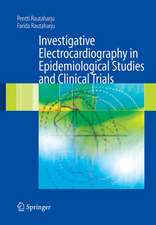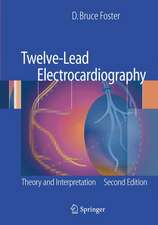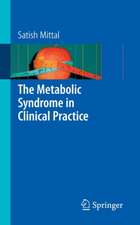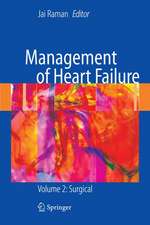Physiological Assessment of Coronary Stenoses and the Microcirculation
Editat de Javier Escaned, Justin Daviesen Limba Engleză Paperback – 3 aug 2018
| Toate formatele și edițiile | Preț | Express |
|---|---|---|
| Paperback (1) | 763.42 lei 39-44 zile | |
| SPRINGER LONDON – 3 aug 2018 | 763.42 lei 39-44 zile | |
| Hardback (1) | 1068.96 lei 39-44 zile | |
| SPRINGER LONDON – 29 aug 2017 | 1068.96 lei 39-44 zile |
Preț: 763.42 lei
Preț vechi: 803.61 lei
-5% Nou
Puncte Express: 1145
Preț estimativ în valută:
146.08€ • 152.22$ • 120.95£
146.08€ • 152.22$ • 120.95£
Carte tipărită la comandă
Livrare economică 31 martie-05 aprilie
Preluare comenzi: 021 569.72.76
Specificații
ISBN-13: 9781447173793
ISBN-10: 1447173791
Pagini: 313
Ilustrații: XIII, 313 p. 158 illus., 131 illus. in color.
Dimensiuni: 210 x 279 mm
Ediția:Softcover reprint of the original 1st ed. 2017
Editura: SPRINGER LONDON
Colecția Springer
Locul publicării:London, United Kingdom
ISBN-10: 1447173791
Pagini: 313
Ilustrații: XIII, 313 p. 158 illus., 131 illus. in color.
Dimensiuni: 210 x 279 mm
Ediția:Softcover reprint of the original 1st ed. 2017
Editura: SPRINGER LONDON
Colecția Springer
Locul publicării:London, United Kingdom
Cuprins
FOREWORD.- INTRODUCTION.- Part 1. The Coronary Circulation in Health and Disease.- STRUCTURE AND PHYSIOLOGY OF THE CORONARY CIRCULATION.- A historical perspective on coronary circulation.- The anatomy of epicardial ,coronary arteries and veins.- The structure of transmural vessels and coronary microcirculation.- Regulation of coronary blood flow.- Myocardial metabolism and blood supply.- Coronary capacitance and the myocardial pump model.- Extravascular compression and vascular waterfalls.- Extrinsic neural control of blood flow.- Hemodynamic effects of epicardial stenoses.- Modification of shear stress by stenoses.- Phasic characteristics in coronary blood flow.- PATHOLOGICAL CHANGES IN CORONARY CIRCULATION.- Epicardial coronary stenosis.- Microvascular remodelling.- Microvascular obstruction.- Extravascular compression of the microcirculation.- Endothelial dysfunction.- Collateral development.- EFFECT OF SPECIFIC PATHOLOGIES ON EPICARDIAL VESSELS AND THE MICROCIRCULATION.- Hypertension and left ventricular hypertrophy.- Diabetes.- Dyslipidemia.- Atherosclerosis. Acute coronary syndromes.- Atherosclerosis. Chronic ischemia.- Acute and chronic effects of percutaneous coronary interventions.- Valvular heart disease.- Part II. Invasive Assessment of the Coronary Circulation in the Catheterization Laboratory.- FRACTIONAL FLOW RESERVE (FFR).- Understanding fractional flow reserve.- Current evidence on FFR as a clinical tool.- Application of fractional flow reserve to specific stenosis subsets.- INSTANTANEOUS WAVE FREE RATIO (iFR).- Physiological principles of iFR.- Validation of iFR. Clinical registries.- Application of iFR in clinical scenarios.- CORONARY FLOW RESERVE.- Understanding coronary flow reserve.- Use of Doppler-tipped guidewires to calculate coronary flow reserve.- Relative and adjusted coronary flow reserve.- Use of the thermodilution principle to calculate coronary flow reserve.- INDICES OF CORONARY RESISTANCE.- Understanding indices of coronary resistance.- Stenosis resistance estimated from pressure-flow relationships.- Myocardial resistance estimated with thermodilution and pressure.- Microcirculatory resistance calculated from intracoronary pressure and Doppler.- Integration of pressure and flow indices of coronary stenosis severity.- WAVE INTENSITY ANALYSIS.- Understanding wave intensity analysis.- Wave patterns in coronary flow in health and disease.- Changes in WIA coronary patterns during trans-arterial valve implantation.- ASSESSMENT OF ENDOTHELIAL DYSFUNCTION.- Understanding endothelial modulation of vascular tone.- Assessment of endothelial dysfunction with acetylcholine challenge.- Other methods to assess endothelial dysfunction.- RESEARCH MODELS.- Relevant differences between coronary circulation in human and experimental animal models.- Computerised fluid dynamics applied to modelling of coronary circulation.
Notă biografică
Javier Escaned MD PhD FESC is Head of Section (Interventional Cardiology) at Hospital Clinico
San Carlos, and Associate Professor of Medicine at Complutense University (Madrid, Spain). He
trained as a cardiologist the United Kingdom (Queen Elizabeth University Hospital, Birmingham
and Walsgrave Hospital, Coventry) before moving to the Thoraxcenter / Rotterdam (The
Netherlands), where he obtained his PhD degree in 1994. He is author of more than 250 scientific
articles, books and book chapters on different aspects of interventional cardiology, imaging and
physiology. He is co-editor with Patrick Serruys of the textbook “Coronary Stenosis. Imaging,
Structure and Physiology”, whose new edition was launched in May 2015. Current positions in
scientific societies include: board member (treasurer) of European Association of Percutaneous
Cardiovascular Interventions (EAPCI), nucleus member of the ESC Working Group on
Pathophysiology and Microcirculation, and co-director of EuroPCR. In 2014 he served as director of
the ESC International Summit on Coronary Microcirculation and Heart Disease. Recent or on-going
international multicentre trials in which he has a principal investigator role include: ADVISE II,
SYNTAX II, PILOT SECRET, SHEAR STENT and DEFINE-FLAIR. Some of his additional
interests are philosophy, education and music.
San Carlos, and Associate Professor of Medicine at Complutense University (Madrid, Spain). He
trained as a cardiologist the United Kingdom (Queen Elizabeth University Hospital, Birmingham
and Walsgrave Hospital, Coventry) before moving to the Thoraxcenter / Rotterdam (The
Netherlands), where he obtained his PhD degree in 1994. He is author of more than 250 scientific
articles, books and book chapters on different aspects of interventional cardiology, imaging and
physiology. He is co-editor with Patrick Serruys of the textbook “Coronary Stenosis. Imaging,
Structure and Physiology”, whose new edition was launched in May 2015. Current positions in
scientific societies include: board member (treasurer) of European Association of Percutaneous
Cardiovascular Interventions (EAPCI), nucleus member of the ESC Working Group on
Pathophysiology and Microcirculation, and co-director of EuroPCR. In 2014 he served as director of
the ESC International Summit on Coronary Microcirculation and Heart Disease. Recent or on-going
international multicentre trials in which he has a principal investigator role include: ADVISE II,
SYNTAX II, PILOT SECRET, SHEAR STENT and DEFINE-FLAIR. Some of his additional
interests are philosophy, education and music.
Textul de pe ultima copertă
Since the introduction of coronary angiography, a key technique in understanding coronary artery disease, a number of paradigms regarding its study and interpretation have taken place. Following an emphasis on improved angiographic and subsequent intracoronary imaging techniques, functional assessment of coronary circulation has demonstrated to have major implications for diagnosis and treatment of coronary artery disease. Fractional flow reserve, a pressure derived index of stenosis severity, constitutes the best example of the current importance of physiological assessment in clinical practice. However, the acceptance of FFR by cardiologists contrasts with important voids in knowledge on the basic principles of coronary physiology and of other available techniques that, as an alternative to FFR, allow a more comprehensive assessment of coronary circulation. This is particularly noticeable in the assessment of microcirculation, an unavoidable compartment of coronary circulation that is frequently affected in acute coronary syndromes of in the presence of cardiovascular risk factors or non-coronary heart disease. A deeper understanding of the relationship between epicardial vessel and microcirculatory involvement has started with the advent of newer imaging techniques like invasive optical coherence tomography, and non-invasive CT and NMR techniques. This book aims to be an indispensable tool for clinicians and researches in the field of coronary artery disease. It provides a balanced, comprehensive review of anatomy, physiology and available techniques, discusses both the diagnosis of epicardial vessel and microcirculatory disease, the impact of different diseases at different levels of coronary circulation, and the best way to address a separate or combined assessment of different levels of coronary circulation.
Caracteristici
Provides a clear and comprehensive review of the principles of coronary physiology Gives a detailed description of available techniques for physiological assessment of coronary circulation in the cathlab Addresses the needs of clinicians and researchers working in the field of coronary artery disease

